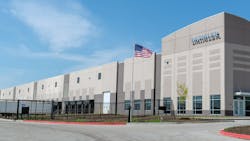In what's shaping up as a banner year for trucking, it's an extremely competitive market among truck manufacturers — even when you're Daimler Trucks North America, which has the largest market share of the U.S. Class 8 segment.
Service can be a major differentiator, and to support ever-shortening goals of customer throughput in maintenance bays requires a "flexible, dynamic" parts distribution network.
To that end, DTNA recently opened its newest parts distribution center, or PDC, just outside of Des Moines, IA. The 245,000-square-foot center in the city of Grimes is the company's ninth in North America, now allowing DTNA to deliver parts to 80% of its dealer locations in 12 hours or less.
"Nobody buys our trucks because they like to buy trucks — they have to buy them as a way to make money," said Stefan Kurschner, senior vice president of aftermarket at DTNA. "The best truck is nothing when it's stopped in a workshop with a service event happening to it."
And the longer a truck sits in service, the longer its driver can't earn money with it, he added, which means minimal truck downtime is tied to driver retention and job satisfaction.
Striving for an optimal "customer service experience," Kurschner explained that things have been changing quickly as DTNA's service turnaround window has shrunk considerably from 72 hours back in 2013-14. Now, with the 12-hour parts delivery window within its dealership network — which the company plans to boost to 90% in the near future — the goal is for dealers to get trucks in and out of service within 24 hours.
To accomplish that, Kurschner said DTNA conducts "center of gravity" studies to determine the best location for a PDC, based on the location of dealers and fleet customers. These studies incorporate traffic flows, local highway infrastructure and known traffic bottlenecks.
"It's a very scientific, analytic process with a lot of variables," Kurschner told Fleet Owner. The PDCs, he said, "are really a crucial building block to make the customer experience the best possible."
He added that there needs to be a "tremendous amount of flexibility" built into the "continuously optimized" parts delivery network to ensure parts get delivered on time, including when there are sudden ordering spikes or severe weather events.
When there's a problem with some interruption — it might be a severe storm, a broken bridge or even a delay like a highway pile-up — DTNA's parts network is designed to be flexible and dynamic enough to allow rerouting and sourcing should a PDC go "offline" for whatever reason.
DTNA noted that dealers can submit stock orders as late as 4 p.m. in some regions of North America and have those parts packed on a truck by 10:30 p.m. and arrive at the dealer's facility before the start of the next business day.
The company is now delivering about 75% by dedicated delivery, rather than using third-party less-than-truckload carriers. Kurschner noted DTNA will announce its next PDC, which will be based somewhere along the West Coast, later this summer.
About the Author
Aaron Marsh
Aaron Marsh is a former senior editor of FleetOwner, who wrote for the publication from 2015 to 2019.
Neil Abt
Neil Abt is a former FleetOwner editor who wrote for the publication from 2017 to 2020. He was editorial director from 2018 to 2020.

